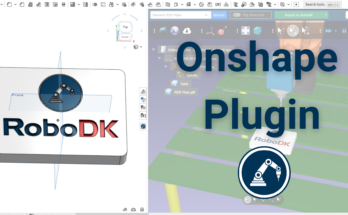Organizations that work with a wide range of industrial robots face the challenge of having to program each robot arm using its unique proprietary software. To address this, RoboDK software allows you to deploy programs on any robot controller. In an interview with Rocking Robots, founder Albert Nubiola compared his ambition to Microsoft’s achievement of creating Windows asan operating system that runs on any PC.
Albert Nubiola, CEO and founder of RoboDK, drew inspiration from the challenges he encountered while programming industrial robots. He recalls, “I began my journey at Pratt and Whitney Canada in 2012. Pratt and Whitney designs and manufactures airplane engines. In the factory, many robots from different brands had to be programmed and maintained. There was a designated specialist for each robot brand, specifically when it came to software and programming. However, when asked about other robots, their knowledge was often limited.”
While working at Pratt & Whitney Canada, Albert saw an opportunity to address this challenge and founded RoboDK in 2015. “The need for a universal software solution became clear to me. As a robot programmer, you may feel locked into the ecosystem of software and hardware of a specific robot brand unless you explore alternative solutions. In contrast, our RoboDK software allows users to program any robot, providing many CAD to path tools and integrations with CAD/CAM software. Though there’s an initial learning curve when learning any new software, RoboDK is designed to be user-friendly, and we provide plenty of resources publicly available, including online documentation, video tutorials and examples.”
Ambition
To draw a parallel, this ambition mirrors what Microsoft achieved for personal computers with Windows. “Our goal is to empower users to master one software and use it to simulate and program any robot. Our mission stays the same since we started RoboDK in 2015: to integrate all robots in RoboDK so our customers can simulate and program any robot using our software.”
While some client’s approach RoboDK with challenges specific to one robot, not all see the broader value the software offers. “With our platform, if a customer decides to expand automation with more robots, they won’t face programming challenges if they choose robots from different manufacturers. Unlike RoboDK competitors, who price based on the robot models used, our pricing structure is transparent and publicly available on our website for all customers. Even though we initially targeted small and medium-sized enterprises, several large corporations have since adopted our solutions, signaling promising growth.”
Free version
RoboDK collaborates with major entities in the robotics industry, even though their software might seem to be in direct competition with proprietary programming solutions. “Our strength comes from embracing modern tools, whereas many of our competitors still rely on software technology from the 1980s. Their need to maintaining backward compatibility may slow innovation. Hence, it’s companies like ours that drive broader innovation and make automation more widely accessible.”
“Our partnerships with numerous robot manufacturers, integrators, universities and the widespread use of our free version have significantly increased our brand’s visibility.”
Automation Challenges
The challenges that the manufacturing industry face span the vast spectrum of robotics applications. “Robotics has expanded beyond traditional automation, covering countless sectors. From robot machining, to artists using robots to draw strokes with oil paint to space agencies like NASA using robots for aircraft inspection, the applications are nearly boundless. An example of an advanced application is robot machining, which is among the most complex in terms of robot controller requirements and software.”
“The six-axis robot arm remains the industry’s most prevalent model. Its dominance comes from its versatility, providing full freedom for 6D positioning in space. Five-axis robots are usually more affordable but less common due to their limited freedom of motion. While seven-axis robots introduce greater freedom, they are usually more complex and expensive. The six-axis variant emerges as the optimal choice. It balances capability with ease of use, making it a versatile tool for a multitude of applications.”
Robot accuracy
Manufacturing applications such as robot machining require high precision as it entails following thousands of points accurately. However, robot arms are known to not be accurate. “At RoboDK we have integrated our CAD/CAM features with robot calibration, one of our premium products. With robot calibration we identify robot errors to improve accuracy up to 0.150 mm. Therefore, when you generate robot programs with a calibrated robot, RoboDK automatically compensates robot errors to generate accurate programs.
“For example, a robot cutting through a straight line will deviate slightly from its path because of inaccuracies. To mitigate this, we break down the line into small segments, accounting for expected deviations at each point to compensate robot errors and cut through a straight line accurately. This rigorous method significantly improves accuracy and is essential for high accuracy tasks, such as furniture crafting.”
Future plans
Looking ahead, Albert anticipates a shift in the robotics landscape towards more budget-friendly automation solutions. “Our company plays a significant role in deploying automation solutions at scale, making automation more affordable and easier. Also many firms, particularly those from China, are achieving notable advancements in hardware.”
“A widespread misconception exists that equates Chinese products with lower quality. In my opinion, some Chinese companies produce good quality robotic arms that match the standards of their Western competitors, yet come at a much lower price.”
This shift underscores China’s escalating prominence in the robot installation domain. Data from the International Federation of Robotics indicates that, in the past year, China’s robot installations exceeded the combined total of installations for the rest of the world.
Innovation at RoboDK
The next significant leap in robotics will come from AI integration. “The challenge lies in its implementation, given the high costs associated with hiring proficient AI programmers.”
He concludes: “We are dedicated to developing new products that make automation more accessible and easier to integrate with existing production lines. Computer Vision is one such area where we’re aiming to enhance our capabilities. Self-calibration procedures is another domain we’re exploring.”
“When it comes to the future of RoboDK, our primary focus is innovation and ease of use. We develop new products based on specific customer requirements that align with our vision. We work on multiple new projects trying to make automation as easy and affordable as possible.
What questions do you have about RoboDK? Tell us in the comments below or join the discussion on LinkedIn, Twitter, Facebook, Instagram, or in the RoboDK Forum.. Also, check out our extensive video collection and subscribe to the RoboDK YouTube Channel.”




